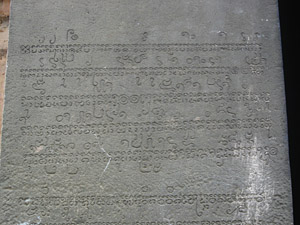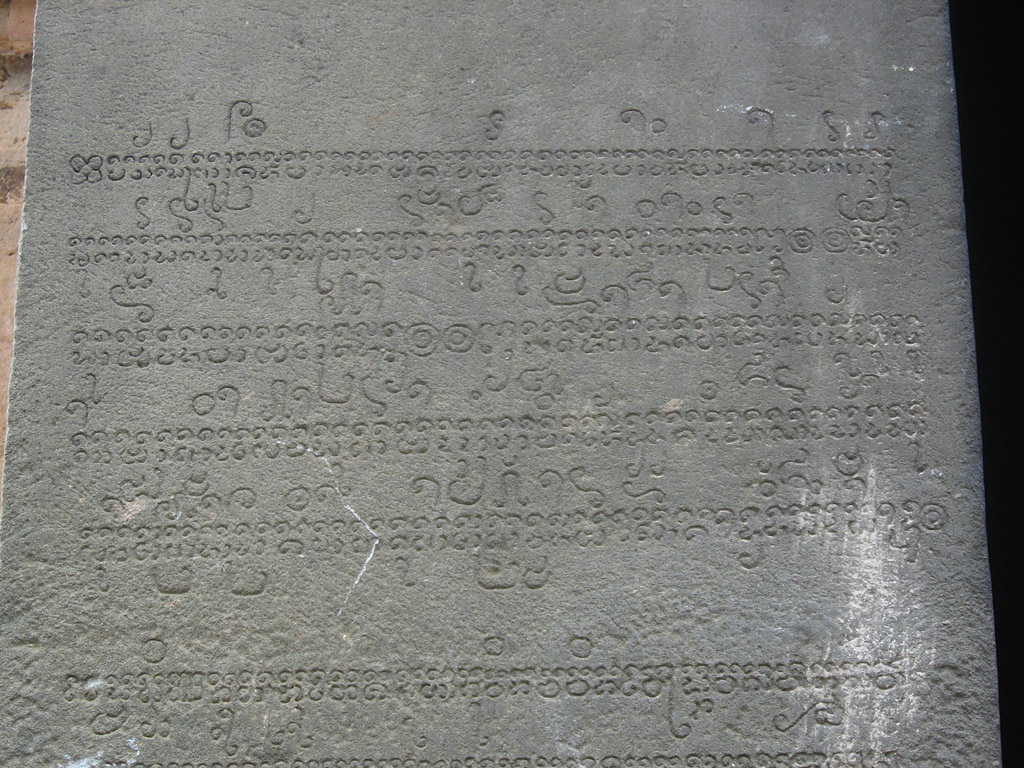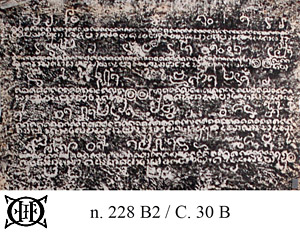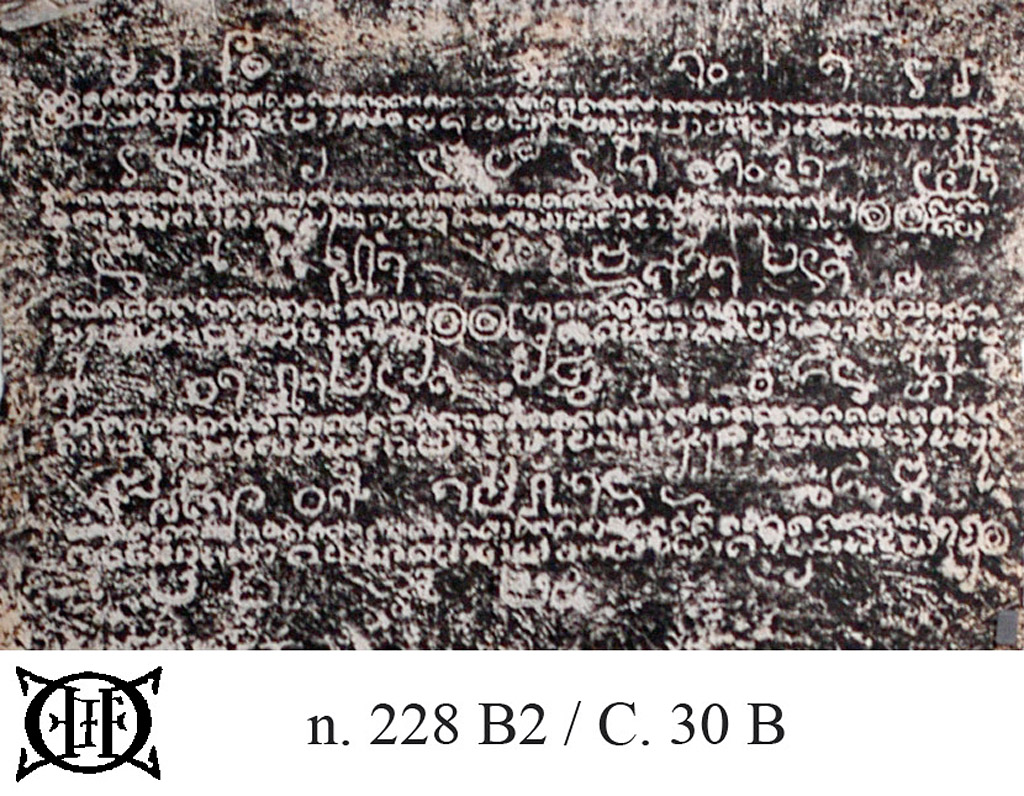Corpus of the Inscriptions of Campā




C. 30 B2 Southern doorjamb of the main shrine of Po Nagar
Please note: you are reviewing a preprint version of this publication. Contents here may change significantly in future versions. Scholars with specific interests are urged to consult all cited bibliography before using our texts and translations or drawing other significant conclusions.
Text The five lines engraved below C. 30 B1, on the anterior face of the Southern doorjamb of entrance to the main shrine. Written in Old Cam.
Date End of the 12th century Śaka (13th century CE).
Origin Temple of Po Nagar at Nha Trang (Khánh Hoà, Vietnam).
This inscription was found in situ before 1888, when it was first mentioned in the literature (Bergaigne 1888: 79). We identified the inscription on the temple site in 2009.
Edition(s) A few words were read in Bergaigne 1888: 88; partially published, with French translation, in Aymonier 1891: 28-29; whence, summed up in English, in Majumdar 1927: 207 and Golzio 2004: 179-180 whence again, with translation into French in Schweyer 2005a: 95-96. The present edition and translation after ECIC IV: 261-262 where we have re-edited the text from the inked EFEO estampage and the stone.
Facsimiles
- Estampage: BnF 409 (60)
- Estampage: EFEO 20
- Estampage: EFEO n. 228.1
The following text was edited by Arlo Griffiths and Amandine Lepoutre.
1 turaiy· vijaya ◇ turaiyvijaya Schweyer. — devakāryya ◇ deva kāñyā Aymonier. — 2 sthāpanā ◇ sthapanā Aymonier. — jāk ◇ jāt Aymonier. — 3 manrauṅ ◇ manroṅ Aymonier. — 8002 ◇ 9002 Aymonier. — laṅgum̃ ◇ laṅgǎu Aymonier; laṅguv Schweyer. — 4 lauv ◇ lov Aymonier and Schweyer. — śarīra ◇ śarira Aymonier. — bhaṇḍāra ◇ caṇḍāla (candala?) Aymonier; candāra Schweyer. — svam̃r ◇ svar schweyer. — 4-5 huluv ◇ hulun Aymonier and Schweyer. — 5 krauṅ ◇ krod Aymonier and Schweyer. — kanūk ◇ kanuk Aymonier and Schweyer. — kraum̃ ◇ kroṅ Aymonier and Schweyer. — māmoga ◇ māso ma Aymonier and Schweyer. Correct māḥ bhoga. — 150 ◇ 15 Aymonier; 17 Schweyer.
Translations
English
Y.P.K. Śrī Jayaparameśvaravarmadeva of Turaiy Vijaya carried out the reinstallation of the image [as] divine service. This P.P.T.R. offered a Svar Sandik rice-field at Drāv; 300 jāk. The rice-field of Udaya to the South [of the previous one] 820 jāk with tandoṅ laṅguv. Slaves – Cams, Khmers, Chinese (?), Paganese [and] Siamese – all together 55 individuals. A svam̃r domain. The sragīk kanūk source the vvaṅ river. Good in gold: 15 thil; in silver: 150.
French
Y.P.K. Śrī Jayaparameśvaravarmadeva de Turaiy Vijaya effectua [en tant que] service pour les dieux la réinstallation de l'image. Ce P.P.T.R. offrit une rizière Svar Sandik à Drāv : 300 jāk. La rizière d'Udaya au sud [de la précédente] 820 jāk avec tandoṅ laṅguv. Des esclaves – Cams, Khmers, Chinois (?), Paganais [et] Siamois – en tout 55 individus. Un domaine svam̃r. La source sragīk kanūk le fleuve vvaṅ. Biens en or 15 thil ; en argent 150.
Commentary
Secondary Bibliography
- Parmentier 1909: 130.
Notes
- There are several estampages under the number n. 228.



The notation 8002 pluḥ in line 3 must no doubt be interpreted as 820. About the Cam use of numeral signs, Aymonier 1889: 38 wrote that “La décadence des études est telle chez les misérables Chams du Bình-Thuận qu'ils ont perdu la notion de la valeur de position des chiffres et écrivent 101, 102, 103, etc., pour 11, 12, 13, etc. Quant à présenter des centaines de chiffres, ils ne s'y aventurent même pas”. At the time he published this inscription, Aymonier 1891: 30, who read 9002, echoed the same attitude, adding: “Et il me semble qu'on trouve déjà ici la trace de cette ignorance. Le lapicide écrit 900 2 suivis de pluḥ 'dizaines', et il y a fort à présumer qu'il a voulu écrire 900 plus 2 dizaines, soit 920 jāk”. Among related writing traditions, this type of procedure does not seem to be widespread. However, one could find some similar cases, in Orissa for instance where people number manuscript folios in a similar way (1002 for 102).